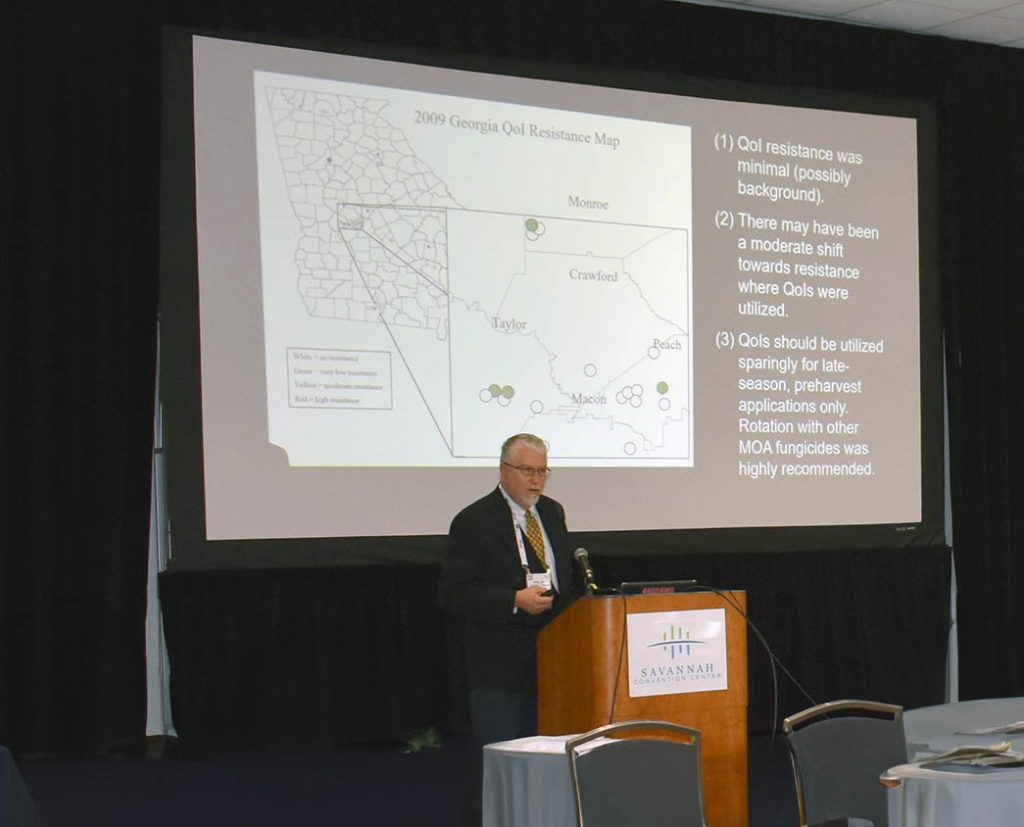
By Clint Thompson
The Southeast Regional Fruit & Vegetable Conference drew a large attendance in early January. The annual gathering provides a plethora of educational breakout sessions focused on key fruit and vegetable crops. Here’s a few highlights from those sessions.

Peach Presentations
Fungicide preservation is the key for Southeast peach producers in managing brown rot disease long term. Demethylation inhibitor (DMI) fungicides have already been compromised to some extent. Growers need to ensure other fungicide classes don’t fall victim as well, explained Phil Brannen, University of Georgia (UGA) Cooperative Extension fruit disease specialist.
“My presentation was on the potential pitfalls of bringing in a (new) product relative to resistance development in the future, and how to incorporate those fungicides to best manage brown rot but also to prevent resistance development in the SDHI (succinate dehydrogenase inhibitor) fungicides.”
Resistance exists in DMI fungicides, though farmers can continue to utilize them in a systems approach with other fungicides.

Chill hours in Florida have been extremely low in recent years. It makes producing peaches, even those requiring minimal chill hours, challenging, if not impossible.
Ali Sarkhosh, University of Florida Institute of Food and Agricultural Sciences (UF/IFAS) assistant professor, spoke about peach production in Florida.
“We have been recording the chill hours in the last seven years from the Fort Pierce area to the central Alachua County area. We see in those areas where peaches have been grown in the last few years, the chill hours have been significantly reduced,” Sarkhosh said. “This year, the chill hour accumulation in Indian River County is zero.”
Watermelon Disease Diagnosis
Anthracnose and downy mildew have similar symptoms in watermelon, so producers should avoid self-diagnosing disease in their crops this season.
Bhabesh Dutta, UGA Extension vegetable plant pathologist, implored growers to consult Extension personnel when deducing what problem they might have. A wrong diagnosis could have financial repercussions.
“What we recommend is getting connected to the Extension agent and getting it confirmed as downy or not,” Dutta said. “We always recommend that growers, if they have any confusion, connect with their respective Extension agent to confirm, and our clinic will help.”
He added that different watermelon diseases require completely different management options with completely different fungicides. “Those fungicides do not overlap with each other,” Dutta warned.
Blueberry Talks
A fungal pathogen that was isolated to South Florida blueberries not too long ago is now on the radar of growers in North Florida and South Georgia.
Phil Harmon, University of Florida Institute of Food and Agricultural Sciences professor and Extension plant pathologist, cautioned farmers about algal stem blotch.
He said the pathogen has been present in South Florida for the last 15 years and is moving north. It has been in Central Florida for the last 10 years, in North Central Florida for the last five years and in South Georgia within the last three years.
Many growers mistake algal stem blotch symptoms for nutrient deficiencies or a chemical burn when they first see it.
Harmon said young blueberry leaves and stems turn bright white on the growing tips when they are infected with the algal stem blotch pathogen.
“It looks similar to a herbicide injury that can bleach plants white,” Harmon said. “This algal pathogen does the same thing. When it infects stems, it secretes some sort of toxin into the vascular system of the plant, which moves up to the growing tips.”
Wes Porter, UGA Extension precision ag and irrigation specialist, focused his presentation on blueberry water needs.
“In the springtime, when plants start getting ready to put on buds and flowers, water usage is going to ramp up all the way through fruit fill,” Porter said.
His talk centered on the SmartIrrigation Blueberry App, a tool designed to help growers know when and how to water their crop. Peak water use is estimated to be between an inch and an inch and a half per week. But producers should be cautious in how they apply the water.
“We’d rather back off and divide that weekly water requirement across the entire week and do it every day or every other day in micro shots,” Porter advised.
Recognition for Drift Reduction
Stanley Culpepper, a weed scientist with UGA, took a moment during one of his presentations in Savannah to give growers a shout-out for good stewardship. Herbicide drift had become a major issue for growers in Georgia, especially when dicamba-resistant row crops came to market. In 2014, the state fielded 289 complaints about herbicide drift.
“Something we don’t like in Extension is a scenario when drift occurs and we have two great farmers who are not happy with one another,” Culpepper said. “Back in 2014, we started the Using Pesticides Wisely program. We implemented that program with UGA Extension and our colleagues with the Georgia Department of Agriculture to prevent drift. In 2023, we only had 29 complaints, which is a 90% reduction from the 2014 count. I want to thank all our growers and applicators for their commitment to stewardship to help us achieve these reductions.”










